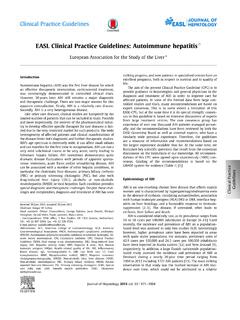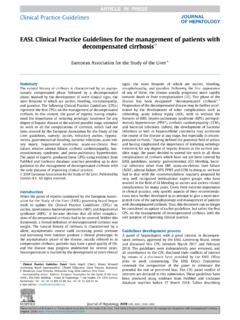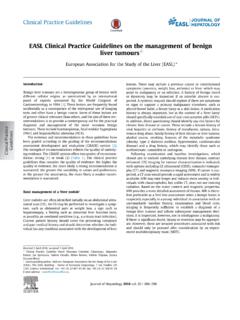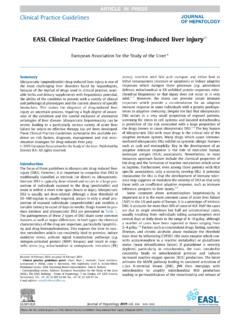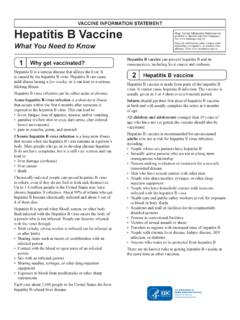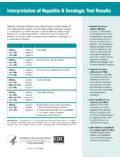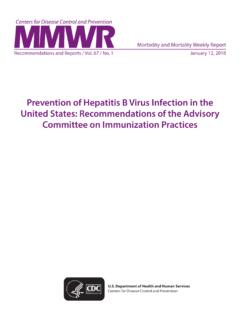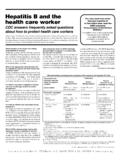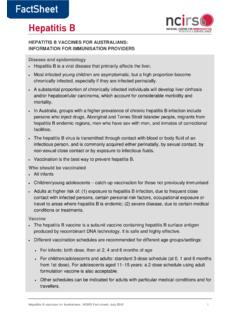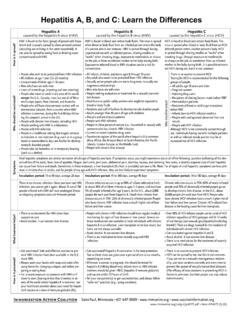Transcription of EASL 2017 Clinical Practice Guidelines on the management ...
1 EASL 2017 Clinical Practice Guidelines on the managementof hepatitis B virus infectionqEuropean Association for the Study of the Liver SummaryHepatitis B virus (HBV) infection remains a global public healthproblem with changing epidemiology due to several factorsincluding vaccination policies and migration. This Clinical Prac-tice Guideline presents updated recommendations for the opti-mal management of HBV infection. Chronic HBV infection canbe classified into five phases: (I) HBeAg-positive chronic infec-tion, (II) HBeAg-positive chronic hepatitis , (III) HBeAg-negativechronic infection, (IV) HBeAg-negative chronic hepatitis and (V)HBsAg-negative phase.
2 All patients with chronic HBV infectionare at increased risk of progression to cirrhosis and hepatocellularcarcinoma (HCC), depending on host and viral factors. The maingoal of therapy is to improve survival and quality of life by pre-venting disease progression, and consequently HCC induction of long-term suppression of HBV replication repre-sents the main endpoint of current treatment strategies, whileHBsAg loss is an optimal endpoint. The typical indication fortreatment requires HBV DNA[2,000 IU/ml, elevated ALT and/orat least moderate histological lesions, while all cirrhotic patientswith detectable HBV DNA should be treated.]
3 Additional indica-tions include the prevention of mother to child transmission inpregnant women with high viremia and prevention of HBV reac-tivation in patients requiring immunosuppression or chemother-apy. The long-term administration of a potent nucleos(t)ideanalogue with high barrier to resistance, , entecavir, tenofovirdisoproxil or tenofovir alafenamide, represents the treatment ofchoice. Pegylated interferon-alfa treatment can also be consid-ered in mild to moderate chronic hepatitis B patients. Combina-tion therapies are not generally recommended. All patientsshould be monitored for risk of disease progression and patients should be monitored for therapy response andadherence.
4 HCC remains the major concern for treated chronichepatitis B patients. Several subgroups of patients with HBVinfection require specific focus. Future treatment strategies toachieve cure of disease and new biomarkers are discussed. 2017 European Association for the Study of the Liver. Publishedby Elsevier All rights with hepatitis B virus (HBV) remains an important glo-bal public health problem with significant morbidity and 3 New information on the pathogenesis and management ofHBV infection has become available since the previous EASL Clin-ical Practice Guidelines (CPGs) prepared in 2011 and published objective of this manuscript is to update the recom-mendations for the optimal management of HBV infection.
5 Inorder to keep the manuscript and particularly the reference listwithin a reasonable length, only references published after2012 have been considered, since the readers can find the oldersupportive references in the 2012 EASL HBV CPGsdo not fully address prevention including vaccination. In addi-tion, despite increasing knowledge, areas of uncertainty still existand therefore clinicians, patients and public health authoritiesmust continue to make choices based on the evolving and public health burdenApproximately 240 million people are chronic HBV surface anti-gen (HBsAg) carriers, with a large regional variation of HBsAg-positive patients between low (\2%) and high ([8%)]
6 ,4 The prevalence is decreasing in several highly endemiccountries due to improvements in the socioeconomic status, uni-versal vaccination programs and perhaps effective antiviral , population movements and migration arecurrently changing the prevalence and incidence in several lowendemic countries in Europe ( , Italy, Germany), owing to thehigher HBsAg prevalence rates in migrants and refugees fromoutside Europe compared with the indigenous ,7 Even with universal vaccination programs, it has been impossibleto substantially prevent acute cases of HBV infection, especiallyin high risk ,9 The number of HBV related deathsdue to liver cirrhosis and/or hepatocellular carcinoma (HCC)Journal of Hepatology2017vol.
7 67j370 398 Keywords: hepatitis B; EASL Guidelines ; Treatment; Interferon; Entecavir;Tenofovir; TAF; HBsAg; Hepatocellular carcinoma; HBV DNA; HBV reactivation;Mother to child 23 March 2017; accepted 23 March 2017qClinical Practice Guidelines panel:Chair: Pietro Lampertico; Panel members:Kosh Agarwal, Thomas Berg, Maria Buti, Harry Janssen, George Papatheodor-idis, Fabien Zoulim; EASL Governing Board representative: Frank Tacke. Corresponding author. Address: European Association for the Study of the Liver(EASL), The EASL Building Home of Hepatology, 7 rue Daubin, CH 1203 Geneva,Switzerland. Tel.: +41 (0) 22 807 03 60; fax: +41 (0) 22 328 07 Practice Guidelinesincreased between 1990 and 2013 by 33%, relating to[686,000cases in 2013 and immunopathogenesisThe viral life cycleHuman HBV belongs to theHepadnaviridaefamily of small, envel-oped, primarily hepatotropic DNA viruses.]
8 In the host, the virusreplicates and assembles exclusively in hepatocytes, and virionsare released non-cytopathically through the cellular secretorypathway. The viral genome shows an extremely compact organ-isation. The small ( kb), partially double-stranded, relaxed-circular (rc) DNA features 4 open reading frames encoding 7 pro-teins: HBeAg (HBV e antigen, secreted dimeric protein), HBcAg(HBV core antigen, viral capsid protein), HBV Pol/RT (polymerase,reverse transcriptase activity), PreS1/PreS2/HBsAg (large, med-ium, and small surface envelope glycoproteins), and HBx (HBVx antigen, regulator of transcription required for the initiationof infection).
9 11,12 Upon viral uptake into hepatocytes, the HBVnucleocapsid is transported to the nucleus to release the rcDNAgenome. In the nucleoplasm, the rcDNA is converted into a cova-lently closed circular DNA (cccDNA), which is wrapped by his-tones to form an episomal chromatinized structure. It thenserves as a transcription template for all viral transcripts thatare translated into the different viral encodingthe capsid protein and the viral polymerase, the pregenomic RNAis reverse transcribed into new rcDNA within the viral capsid. TheDNA containing nucleocapsids in the cytoplasm are either recy-cled into the nucleus to maintain cccDNA reservoir, or envelopedand secreted via the endoplasmic addition tocomplete infectious virions (diameter of 42 nm), infected cellsproduce a large excess of genome-free, non-infectious sub-viralspherical or filamentous particles of 22 genome inte-gration in the host genome can occur randomly.
10 It is not requiredfor viral replication, but is one of the important mechanismsinvolved in hepatocyte variability of HBVThe lack of reverse transcriptase proofreading activity leads tofrequent mutations of the viral genome. This results in the coex-istence of genetically distinct viral species in infected individuals,also called viral quasispecies, which evolve depending on thepressure from the host environment. The interplay between thevirus, hepatocyte and the immune response or antiviral treat-ment is thought to drive the emergence of HBV mutants thathave the capacity to escape immune responses or antiviral treat-ments.

